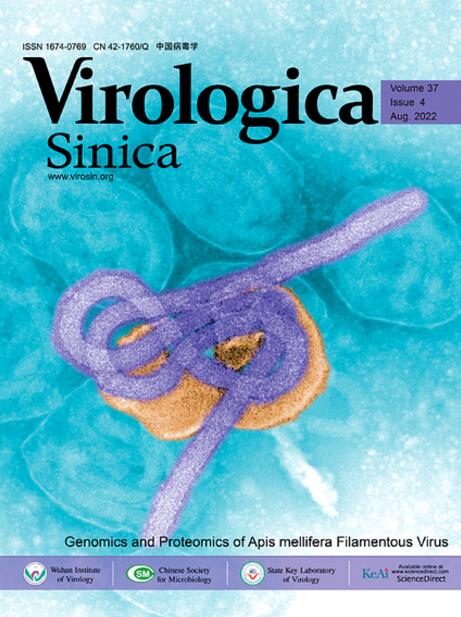鉴定新型 Caspase 裂解基序 AEAD。
IF 5.5
3区 医学
Q1 Medicine
引用次数: 0
摘要
许多病毒感染会诱导caspase活化,从而调控多种细胞通路,包括程序性细胞死亡、免疫信号转导等。鉴定 caspase 的裂解位点和底物对于了解 caspase 激活的调控机制非常重要。在这里,我们发现并分析了一种新型的caspase裂解基序AEAD,并证实了它在一氧化氮相关蛋白1(NOA1)等天然底物中的依赖性裂解活性。将增强型绿色荧光蛋白(EGFP)与线粒体标记蛋白 Tom20 通过 AEAD 基序肽结合,可将 EGFP 定位于线粒体。当仙台病毒(SeV)或 1 型单纯疱疹病毒(HSV-1)感染引发树突酶活化时,由于树突酶介导的裂解,EGFP 在细胞内弥漫定位,因此可以直观地检测病毒诱导的树突酶活化。研究人员开发了一种由 AEAD 肽衍生的抑制剂 Z-AEAD-FMK,它能显著抑制 caspase-1、-3、-6、-7、-8 和-9 的活性,表现出广泛的 caspase 抑制作用。该抑制剂还能进一步阻止 Caspases 介导的下游底物(包括 BID、PARP1、LMNA、pro-IL-1β、pro-IL-18、GSDMD 和 GSDME)的裂解,从而保护细胞免受病毒诱导的细胞凋亡和猝死。总之,我们的研究结果为鉴定新型树突酶裂解基团、开发新型树突酶抑制剂和抗炎药物提供了新的视角。本文章由计算机程序翻译,如有差异,请以英文原文为准。
Identification of a novel caspase cleavage motif AEAD
Infections of many viruses induce caspase activation to regulate multiple cellular pathways, including programmed cell death, immune signaling and etc. Characterizations of caspase cleavage sites and substrates are important for understanding the regulation mechanisms of caspase activation. Here, we identified and analyzed a novel caspase cleavage motif AEAD, and confirmed its caspase dependent cleavage activity in natural substrate, such as nitric oxide-associated protein 1 (NOA1). Fusing the enhanced green fluorescent protein (EGFP) with the mitochondrial marker protein Tom20 through the AEAD motif peptide localized EGFP to the mitochondria. Upon the activation of caspase triggered by Sendai virus (SeV) or herpes simplex virus type 1 (HSV-1) infection, EGFP diffusely localized to the cell due to the caspase-mediated cleavage, thus allowing visual detection of the virus-induced caspase activation. An AEAD peptide-derived inhibitor Z-AEAD-FMK were developed, which significantly inhibited the activities of caspases-1, -3, -6, -7, -8 and -9, exhibiting a broad caspase inhibition effect. The inhibitor further prevented caspases-mediated cleavage of downstream substrates, including BID, PARP1, LMNA, pro-IL-1β, pro-IL-18, GSDMD and GSDME, protecting cells from virus-induced apoptotic and pyroptotic cell death. Together, our findings provide a new perspective for the identification of novel caspase cleavage motifs and the development of new caspase inhibitors and anti-inflammatory drugs.
求助全文
通过发布文献求助,成功后即可免费获取论文全文。
去求助
来源期刊

Virologica Sinica
Biochemistry, Genetics and Molecular Biology-Molecular Medicine
CiteScore
7.70
自引率
1.80%
发文量
3149
期刊介绍:
Virologica Sinica is an international journal which aims at presenting the cutting-edge research on viruses all over the world. The journal publishes peer-reviewed original research articles, reviews, and letters to the editor, to encompass the latest developments in all branches of virology, including research on animal, plant and microbe viruses. The journal welcomes articles on virus discovery and characterization, viral epidemiology, viral pathogenesis, virus-host interaction, vaccine development, antiviral agents and therapies, and virus related bio-techniques. Virologica Sinica, the official journal of Chinese Society for Microbiology, will serve as a platform for the communication and exchange of academic information and ideas in an international context.
Electronic ISSN: 1995-820X; Print ISSN: 1674-0769
 求助内容:
求助内容: 应助结果提醒方式:
应助结果提醒方式:


